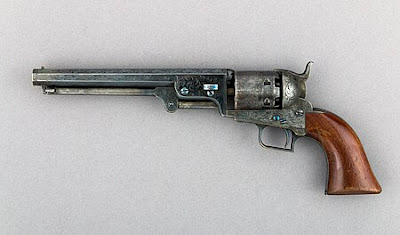 |
| 1851 Colt Navy Reproduction. Photo Source: Click here. |
The Colt Revolving Belt Pistol or Navy Pistol, sometimes erroneously referred to as "Colt Revolving Belt Pistol of Naval Caliber" or "of Navy Caliber", is a .36 caliber, six-round cap and ball revolver that was designed by Samuel Colt between 1847 and 1850, which ran parallel with his efforts to revisions made to the Walker that would result in the Dragoon series of revolvers. Despite the "Navy" designation, the revolver was chiefly purchased by civilians and military land forces. The nomenclature "Navy Caliber" would later be applied to any revolver using a .36 caliber bullet.
 |
| Photo Source: Click here. |
Interestingly, Colt’s 1851 Navy revolver, their 1860 Army Model and the 1861 Navy Model, all sport cylinder scenes of a naval conflict. If you look closely at the cylinders, you’ll find the legend “Engaged 16 May 1843,” along with the flags of the young Texas Republic and the early Mexican colors flying from the ships’ masts. This date, along with the nautical imagery, represents a seaborne battle in which Texas’s Commodore Edwin Ward Moore defeated a superior (in both number of ships and their size) fleet of Mexican warships—a crucial event in Texas’s struggle for independence. This naval scene was another shrewd move on the part of Colonel Sam, since he was purposely catering to the Texas market that had been so prosperous for him in the past. Ironically, the opposing parties in this watery engagement never got close enough to each other to use any of Colt’s revolvers or longarms. But why ruin the beauty of a thing with the truth? 

This closeup photo a an 1851 cylinder shows Colts Patent Number, and the well-worn naval battle scene.
 |
| Colt 1851, Serial #2. Photo Source: Click here. |
The discovery of gold in California stimulated the demand for firearms, and Colt also received orders from Russia and Turkey during the Crimean War. He expanded his operations to England, operating a manufacturing plant in London between 1853 and 1857. By this time, Colt operated the world's largest private armory, and he had introduced standardized production, division of labor, and assembly-line mass-production methods to his factory.
Ian McCollom did a piece on an 1851 that was equipped with a shoulder stock that doubled as a canteen. A fun watch.
Variants Vs. Upgrades: Most of my on-line references will discuss cataloged variations of collectable firearms. I think it safe to say that a variant identifies a limited production run of identical specimens that can be verified by company records. At one time Colt kept meticulus records of their firearms, and within a given model and serial number, coud identify its date of manufacture and where, and to whom, it was shipped. Upgrades made by the factor are a different story. When shooters complained about the dropping loading lever of the original, it would have been possible to send it back to the factory and have the newer style Dragoon loading lever installed and the barrel catch lug dovetailed into the barrel. Researchers have found a variety of Walkers retrofitted with updated features, which make an unaltered revolver extremely rare. Revolvers were expensive, and upgrades a way to "modernize" an old revolver.
Fantasy Guns: There have been a number of percusson revolver replicas that ball into the category of "fantasy gun", meaning that they never actually existed as factory original. One that I personally encountered was an "1851 Army Revolver", which combined the general appearance of the '51 Navy in a caliber it was never manufactured in.
 |
| Pieta Fantasy Revolver. Photo Source: Click here. |
I admit that the revolver is a visually pleasing combination of the best of both of the classic Colt revolvers, and it that's what you want, be my guest. You can purchase one such revolver here.
Code: clt01
